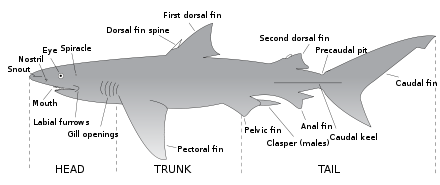Anatomy
Teeth

The teeth of the tiger shark are oblique and serrated for sawing through flesh.
Main article: Shark teeth
Shark teeth are embedded in the gums rather than directly affixed to the jaw, and are constantly replaced throughout life. Multiple rows of replacement teeth grow in a groove on the inside of the jaw and steadily move forward as in a "conveyor belt"; some sharks lose 30,000 or more teeth in their lifetime. The rate of tooth replacement varies from once every 8–10 days to several months. In most species teeth are replaced one at a time, except in cookiecutter sharks the entire row of teeth is replaced simultaneously.Tooth shape depends on diet: sharks that feed on mollusks and crustaceans have dense flattened teeth for crushing, those that feed on fish have needle-like teeth for gripping, and those that feed on larger prey such as mammals have pointed lower teeth for gripping and triangular upper teeth with serrated edges for cutting. The teeth of plankton-feeders such as the basking shark are smaller and non-functional.
Skeleton
Shark skeletons are very different from those of bony fish and terrestrial vertebrates. Sharks and other cartilaginous fish (skates and rays) have skeletons made of cartilage and connective tissue. Cartilage is flexible and durable, yet has about half the density of bone. This reduces the skeleton’s weight, saving energy. Sharks have no rib cage and therefore on land a shark's own weight can crush it.Jaw
Like its relatives, rays and skates, the shark's jaw is not attached to the cranium. The jaw's surface, like the shark's vertebrae and gill arches, needs extra support due to its heavy exposure to physical stress and its need for strength. It has a layer of tiny hexagonal plates called "tesserae", which are crystal blocks of calcium salts arranged as a mosaic. This gives these areas much of the same strength found in the bony tissue found in other animals.Generally sharks have only one layer of tesserae, but the jaws of large specimens, such as the bull shark, tiger shark, and the great white shark, have two to three layers or more, depending on body size. The jaws of a large great white shark may have up to five layers. In the rostrum (snout), the cartilage can be spongy and flexible to absorb the power of impacts.
Fins
Fin skeletons are elongated and supported with soft and unsegmented rays named ceratotrichia, filaments of elastic protein resembling the horny keratin in hair and feathers. Sharks can only drift away from objects directly in front of them because their fins do not allow them to move in the tail-first direction.Dermal denticles
Unlike bony fish, sharks have a complex dermal corset made of flexible collagenous fibers and arranged as a helical network surrounding their body. This works as an outer skeleton, providing attachment for their swimming muscles and thus saving energy. In the past, sharkskin has been used as sandpaper. Their dermal teeth give them hydrodynamic advantages as they reduce turbulence when swimming.Tails
Varying tail shapes have evolved in sharks adapted for different environments. Tail (caudal fins) vary considerably between species. The tail provides thrust, making speed and acceleration dependent on tail shape. Sharks possess a heterocercal caudal fin in which the dorsal portion is usually noticeably larger than the ventral portion. This is because the shark's vertebral column extends into that dorsal portion, providing a greater surface area for muscle attachment. This allows more efficient locomotion among these negatively buoyant cartilaginous fishes. By contrast, most bony fishes possess a homocercal caudal fin.The tiger shark's tail has a large upper lobe which delivers maximum power for slow cruising or sudden bursts of speed. The tiger shark must be able to twist and turn in the water easily when hunting to support its varied diet, whereas the porbeagle, which hunts schooling fish such as mackerel and herring has a large lower lobe to help it keep pace with its fast-swimming prey. Some tail adaptations have other purposes. The thresher feeds on fish and squid, which it herds and stuns with its powerful and elongated upper lobe.


0 comments:
Post a Comment